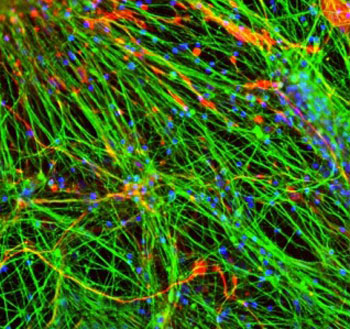New Approach Yields Stable Neural Stem Cell Lines for Neuroscience Research
By LabMedica International staff writers
Posted on 27 Sep 2016
A team of neurosciences researchers developed a faster and more stable technique for establishing stable human induced neural stem cell (hiNSC) lines through the direct reprogramming of neonatal fibroblasts and adult adipose-derived stem cells.Posted on 27 Sep 2016
Limited availability of human neurons poses a significant barrier to progress in biological and preclinical studies of the human nervous system. Current stem cell-based approaches of neuron generation are still hindered by prolonged culture requirements, protocol complexity, and variability in neuronal differentiation.

Image: Neuromuscular tissue engineering: hiNSCs (red) grown in co-culture with skeletal muscle (green), with cell nuclei visualized by blue DAPI staining (Photo courtesy of Dr. Dana M. Cairns, Tufts University).
To increase the pool of neurons for research purposes, investigators at Tufts University (Medford, MA, USA) employed direct reprogramming of neonatal fibroblasts and adult adipose-derived stem cells. According to their approach, once removed from mouse embryonic fibroblasts (MEFs) and dissociated into single-cell suspension, hiNSCs robustly differentiated into about 80%–90% betaIII-tubulin (TUJ1)-, MAP2-, and NEUN-positive neurons in as few as four days, independently of media composition.
The authors reported in the August 25, 2016, online edition of the journal Stem Cell Reports that these hiNSCs could be passaged indefinitely and cryopreserved as colonies. When injected into an early stage chicken embryo, the hiNSCs incorporated into the brain as well as the neurons of the peripheral nervous system that innervate tissues in a developing limb. Furthermore, they demonstrated the utility of these cells in co-culture with skeletal muscle as well as a three-dimensional tissue model of the human brain.
“This discovery could help reduce a significant barrier to progress in biological and in vitro studies of the human nervous system,” said senior author Dr. David L. Kaplan, professor of biomedical engineering at Tufts University. “Initial results suggest that hiNSCs are useful for future biomedical applications such as high-throughput drug assays, complex innervated co-cultures, and three dimensional models using normal and diseased cells.”
Related Links:
Tufts University













